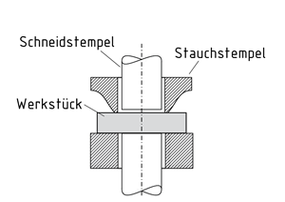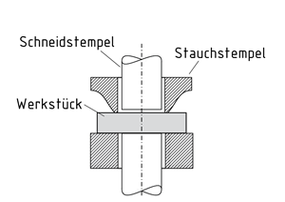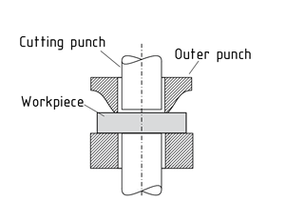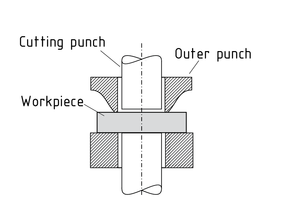
一种定义
四种语言
0,1,2
- 德國
- 英語
- 中國
- 西班牙語
反向冲模剪切

反向冲模剪切是一种特殊的(分离)工艺,用于制造光滑无毛刺切边。首先使用中空外冲头切掉工件并压缩到其原始厚度的 25~30% 之间。外冲头也被称为中空镦锻冲头。
然后使用切割冲头切割工件的剩余厚度。喷射器将工件从机器中传送出来。
这种工艺可以用于切割金属和酚醛树脂或环氧树脂材料的层压体。反向冲模剪切也适用于切割玻璃纤维增强塑料。材料对切割边缘的质量影响不大。
反向冲模剪切工序
Stauchschneiden

Das Stauchschneiden ist ein Sonderverfahren des Schneidens (Zerteilens), mit dem glatte und gratfreie Schnittflächen erzeugt werden können. Mit einem hohlen Außenstempel wird das Werkstück zunächst abgeschert und dabei auf 25 bis 30 Prozent seiner Ursprungsdicke gestaucht. Der Außenstempel wird darum auch als hohler Stauchstempel bezeichnet.
Anschließend wird die Restdicke des Werkstücks mit dem eigentlichen Schneidstempel getrennt. Ein Auswerfer befördert das Werkstück aus der Maschine.
Neben Metallen können auch Schichtpressstoffe aus Phenol- oder Epoxidharz geschnitten werden. Auch für glasfaserverstärkte Kunststoffe eignet sich das Stauchschneiden. Der Einfluss des Werkstoffs auf die Qualität der Schnittfläche ist dabei gering.
Opposed dies shearing

Opposed dies shearing is a special Cutting (Separating) process used to create smooth and burrless cut edges. The workpiece is first sheared off using a hollow outer punch and compressed to between 25 and 30 percent of its original thickness. The outer punch is also known as a hollow Upsetting punch.
The cutting punch is then used to cut the residual thickness of the workpiece. An ejector conveys the workpiece out of the machine.
This process can be used to cut both Metals and laminate made of phenolic or epoxy resin. Opposed dies shearing is also suitable for glass-fibre-reinforced plastics. The Material has little impact on the quality of the cut edge.
Cizallamiento con troqueles opuestos

El cizallamiento con troqueles opuestos es un proceso de (separación) especial usado para crear bordes de corte suaves y sin rebaba. La pieza de trabajo es cortada primero con un punzón exterior hueco y comprimida en un 25 y 30 % de su espesor original. El punzón exterior también es conocido como un punzón de recalcado hueco.
El punzón de corte luego se usa para cortar el espesor residual de la pieza de trabajo. Un eyector transporta la pieza de trabajo fuera de la máquina.
Este proceso puede usarse para cortar tanto metales como láminas hechas de resina epóxica o fenólica. El cizallamiento con troqueles opuestos también es adecuado para plásticos reforzados con fibra de vidrio. El material tiene un impacto pequeño en la calidad del borde de corte.
Proceso de cizallamiento con troqueles opuestos
